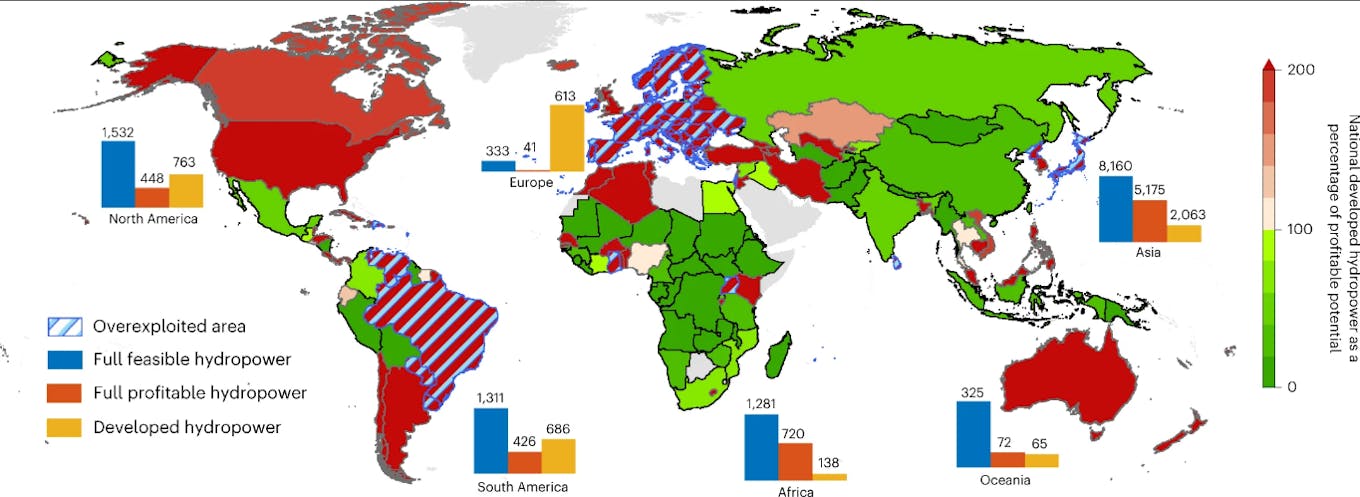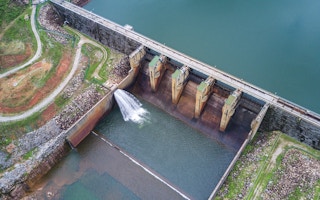Three Southeast Asian nations – Laos, Myanmar and Indonesia – have been identified as sites where hydropower projects can be run profitably with limited environmental impact, as long as strict environmental constraints are in place.
In an attempt to redress the negative perceptions of hydropower projects, an international team of scientists has named potential locations where hydropower stations can be sited with limits placed on environmental damage. Sites that would come at an environmental cost were removed from the list.
The new research, recently published in science journal Nature found Laos, Myanmar and Indonesia among the top 20 countries in the world with the most unused profitable hydropower potential. Together, Asia and Africa account for 85 per cent of global unused potential.
In addition, the study found that Laos and Myanmar could potentially fully meet their total current electricity demand just by developing their unused hydropower resources.
Professor Joseph Holden, director of the research group at the University of Leeds and one of the international team of scientists involved in the project, acknowledged the controversy surrounding hydropower schemes due to their negative impacts. There have been instances where communities are displaced, or forest or peatland ecosystems disturbed with the building of hydropower dams.
However, he pointed out that the team’s detailed analysis shows there is another side to the story. “With careful planning and development, hydropower can make an important contribution to electricity generation. This major piece of work identifies where those sites are in the world,” he said.
“Hydropower can bring major benefits reducing the demand on coal or gas fired plants which are contributing to climate change.”
Hydropower projects along the Mekong river, such as the planned Phou Ngoy dam in Laos and several in Vietnam, have been hit with significant criticism in recent months from locals and environmentalists. The study, based on a set of parameters where hydropower plant development in sensitive areas such as heritage areas, biodiversity hotposts, forests, peatlands or earthquake-prone zones are directly excluded, found that Southeast Asian countries like Vietnam, Malaysia and the Philippines have exceeded their full profitable hydropower potential.
Thailand, to a lesser extent, is not suitable for further hydropower expansion too, the study found.
In these countries, there is hardly any unused profitable hydropower potential, data showed. Additionally, authors of the study said that their analysis does not support the ongoing development of small diversion plants in Vietnam because of their economic costs. Diversion hydropower depends on the natural flow of rivers instead of the construction of large reservoirs.
“If a reservoir floods a tropical forest, it will cause a lot of deforestation and emit much carbon dioxide. In the framework of our quantitative study of hydropower, we do not allow reservoirs to be built in tropical forests,” Xu Rongrong, one of the lead authors of the study told Eco-Business.
As Philippines, Malaysia, Vietnam and Thailand have too many tropical forests, hydropower cannot be developed on a large scale in these countries, he said.

National developed hydropower as a percentage of full profitable potential. The green areas represent countries in which hydropower development can be continued, the red areas represent countries whose developed hydropower exceeds the full profitable potential and the red hatched areas indicate countries whose developed hydropower exceeds the full feasible potential. The bar charts represent the full feasible, full profitable and developed hydropower of each continent. Image: Xu, R., Zeng, Z., Pan, M. et al./ Nature Water
Xu acknowledged that resevoirs might be necessary in specific locations, such as some mountainous areas of Thailand, to supply water for agricultural irrigation and living.
“Building reservoirs in tropical forest areas do have negative environmental impacts, but I can’t tell you that these reservoirs shouldn’t exist. We need to strike a balance between economic development and environmental protection based on local conditions, which is also the core spirit of this research,” he said.
According to Xu, the team of researchers are also looking for a suitable location for the construction of a reservoir around Ho Chi Minh City in Vietnam, using the quantitative framework. “We want to find a location that considers environmental protection and ensures agricultural irrigration water for the local government.”
Hydropower currently accounts for 14.5 per cent of total electricity generated in South and Southeast Asia, according to data from the International Energy Agency.
Beyond Southeast Asia
Hydropower development has been “extremely exploited” in Europe and Brazil, the research showed. Although some regions such as Canada, Russia, the Andes, southern Africa, Indonesia, and Papua New Guinea have recorded an increase in profitable hydropower potential over the past 40 years, the opposite has been true for the United States, Europe and Central Africa.
China has the highest existing hydropower production but also the world’s largest unused profitable potential, particularly in mountainous provinces. Data from the study showed that this potential hydropower could meet 30 per cent of the country’s energy demand.
The Himalayas, Asia’s water tower, have the greatest potential for hydropower expansion, and many planned reservoirs are already under construction in the region, the study said. However, these projects have been marred by protests from residents of the surrounding areas and experts in the region.
In addition, with climate change accelerating the melting of glaciers, it is likely that more reservoirs must also be built to withstand flooding and maintain year-round water supply while balancing the risks of floods from dammed rivers, the study said. A separate study has indicated that silting is an increasingly common problem in ageing reservoirs across Asia.
“Future climate change could increase or decrease hydropower production through changes in precipitation, evaporation, glacier melt, sediment load and extreme cascading hazards, but these changes and their impacts on the global profitable hydropower potential are extremely challenging to quantify,” it said.










